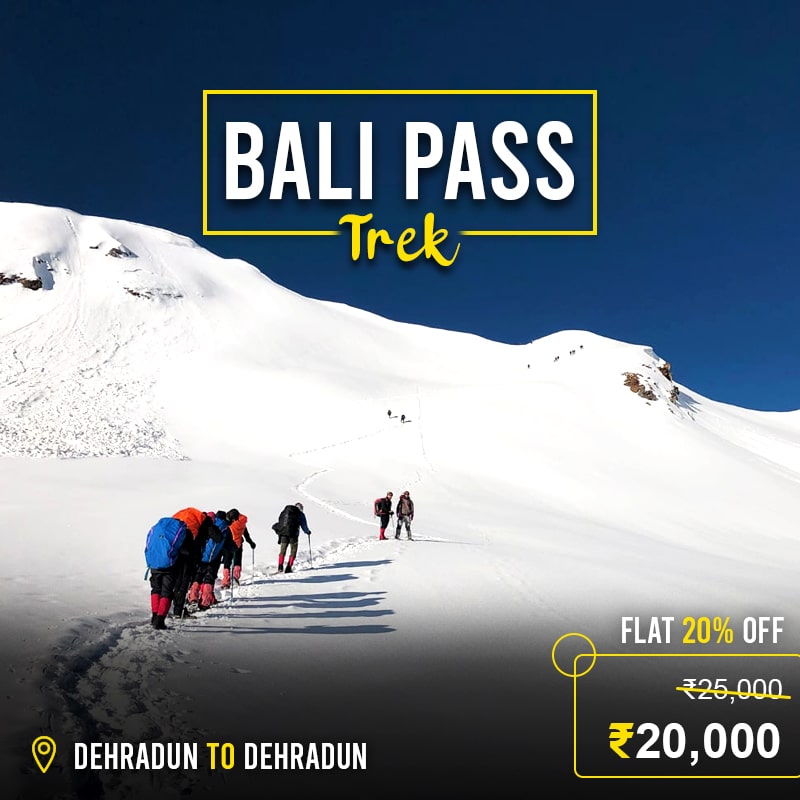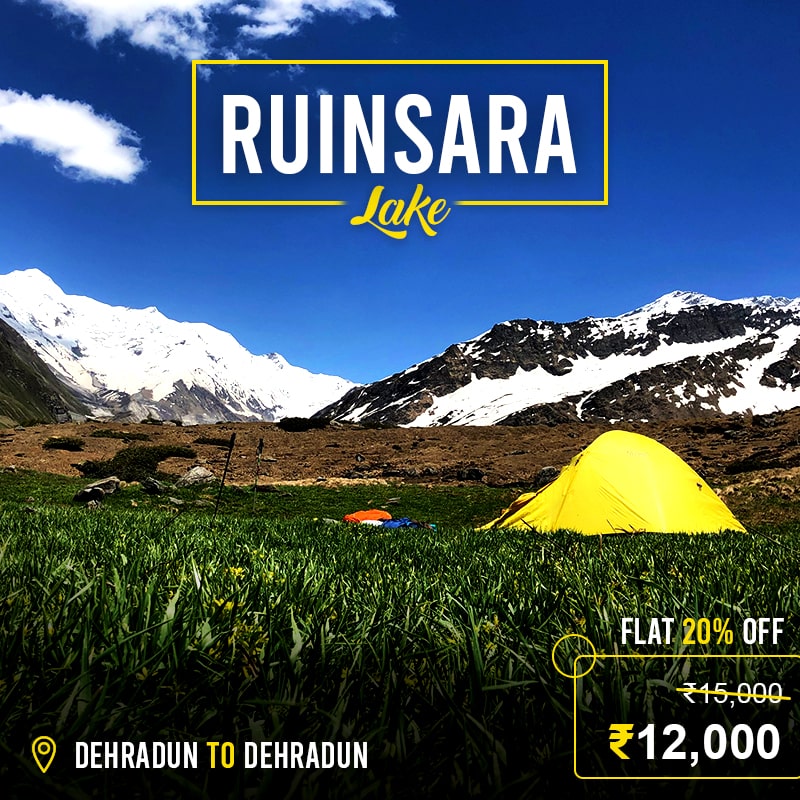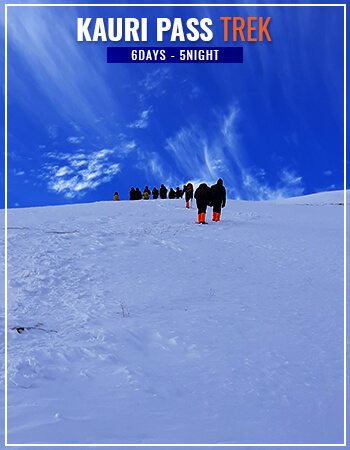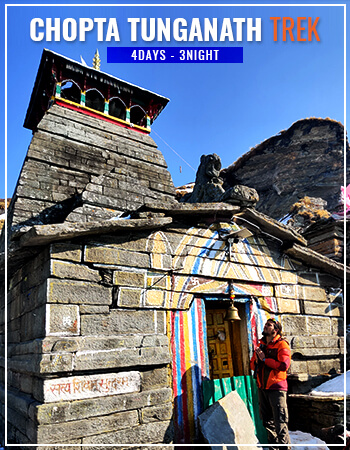KHIMLOGA PASS TREK
9 Days - 8 Night
9 Days - 8 Night
18,740 ft.
Moderate
Sankri
ABOUT
KHIMLOGA PASS TREK
This high altitude pass is located in the Dhauladhar range, between Uttarakhand and Kinnaur, at an elevation of 5,712 meters. Khimloga Pass is not easy to conquer; in fact, only locals visit this place. However, anyone looking for a thrilling adventure should participate in this expedition.
SHORT ITINERARY
-
DAY 1
From Dehradun towards Sankri
-
DAY 2
From Sankri towards Jakhol and from Jakhol towards Liwari via Baicha (4/5 hours)
-
DAY 3
From Liwari towards Surmola Thach (10 km)
-
DAY 4
From Surmola Thach towards Vishkhopri (9 km)
-
DAY 5
From Vishkhopri towards Lower Thangal Thach via Nishani Thach (8 km)
-
DAY 6
From Lower Thangal Thach towards Khimloga camp 1 (7 km)
-
DAY 7
From Khimloga camp 1 towards Khimloga camp 2 (5 km)
-
DAY 8
From Khimloga camp 2 towards Janspad Gad via Khimloga Pass (5.2km)
-
DAY 9
From Janspad Gad towards Chitkul village
DETAILed ITINERARY
Day 1: From Dehradun towards Sankri
Enjoy the smooth ride till Sankri. It is a small village with few homes. It has a well-known mini-market with a few wooden huts serving traditional and delectable food. You can see several mountain ranges from here; it is surrounded by forests, and the air is pollution-free; take in the beauty of Sankri.
Day 2: From Sankri towards Jakhol and from Jakhol towards Liwari via Baicha (4/5 hours)
At an altitude of 2200 metres, Jakhol is 19 kilometres from Sankri and the last village of the Supin valley. It would take you two hours to get there. The trek begins in Jakhol and continues along the left bank of the Supin River until it reaches Baicha, where it crosses a bridge. Obra Gad is visible from this vantage point, and this Gad can also be used to travel to Devkiyara. The trek now continues along the Supin River, with views of Fithari village, which includes fields and wooden huts. The tough climb begins now, and you can enter fields on the left bank of Supin. Trek via potato fields to Liwari village, which is located after the last ridge (2,750 m). Set the camps for the night.
Day 3: From Liwari towards Surmola Thach (10 km)
Early in the morning, go to Someshwar Devta’s temple, bow down, and pray for it to go smoothly. The first part of your trek is through potato fields, and Sural Dhar can be seen from here. The other portion of the trek begins in the woods, with a number of trees such as Deodar, Walnut, and Pine, and continues for 1 km to a Supin bridge. The region is vulnerable to landslides, and some roads have been destroyed as a result. The trek to Surmola Thach is now difficult due to ice bridges and boulder zones. Surmola Thach has lush pasturelands and is 3460 metres above sea level. There is a lake called “Badasu” on the ridge top, and locals believe it is holy and pure. Set the camps for the night.
Day 4: From Surmola Thach towards Vishkhopri (9 km)
Leave the enticing fields of Surmola Thach behind and navigate the right bank of the Supin. Now, proceed with caution through the landslide-prone area, as some pathways have been swept away and others have been destroyed. Climbing the ridge is difficult due to damaged sections, but once you reach the summit, there is a blooming land that provides a welcome relief to the legs after such a strenuous ascent. The scenic beauty is simply heartwarming; there are bright flowers and lush green fields that combine to create a picturesque scene. Begin descending towards Supin to enter your campsite, Vishkhopri, which is located at the Supin-Guggal Gad confluence. Vishkhopri is a large area with several different types of flowers blooming.
Day 5 : From Vishkhopri towards Lower Thangal Thach via Nishani Thach (8 km)
After breakfast, depart for Thangal Thach, where you will see Guggal Gad, which descends from Baslawatha, as you begin your trek. Baspa Valley and Devkiyara Ridge can be reached by following the stream. The ridge top has unexpectedly breathtaking 360-degree views of the Khimloga Glacier, with views of other peaks seen to the left. This glacier is divided into two parts (the largest one is in the front) (part of the North glacier on left). We’ll go to the northern part of the island. By travelling along the Basalwa Thach and boulder field, you can hit Nishani Thach. You can also travel to Baspa Valley via Pataki Dhar from here. 1 km ahead, you’ll find your campsite Thangal Thach, where you’ll have a nice stay in tents.
Day 6: From Lower Thangal Thach towards Khimloga camp 1 (7 km)
Today you must enter Khimloga camp 1. Begin your trek over snow through a moraine forest, with a glacier with crevasses ahead. You must exercise extreme caution because they have the potential to become very dangerous. There is a 70-degree moraine wall that leads to the steep peak of the mountain. Have views of the massive Khimloga Glacier; the sights can both frighten and delight you. The rocks and snowballs coming from above can be scary, but you can conquer these obstacles by using your abilities. The north glacier is broken, making the climb more challenging. Crossing the moraine ridge is risky because one fall will turn dangerous. Be cautious and you’ll be fine. You’ll reach the sharpest ridgetop now, with a view of Khimloga Pass (5,712 m). Arrive at Khimloga Camp 1, take a break after setting up your camps, and our skilled guides will check the route conditions for a smoother trek. In the tents, eat and sleep early.
Day 7: From Khimloga camp 1 towards Khimloga camp 2 (5 km)
You must begin your trek early in order to reach the glacier’s snout. After beginning, descend and cross the moraine ridge’s wall through the boulder field, keeping an eye out for dropping rocks. Now you can see a hanging iceberg with a terrifying black snout. The track is not challenging or steep; all you have to do is cross ice ridges to reach the top of a final snow ridge. Then you’ll be surprised to see Khimloga Pass and the semi-circular Khimloga glacier. There is an ice field with crevasses farther on, and you must continue walking on the right side of the glacier before you find a glacial reservoir. Lunch will be served in the middle of the hike; a packed lunch will be delivered. Reach camp 2 and set up the tents for the night.
Day 8: From Khimloga camp 2 towards Janspad Gad via Khimloga Pass (5.2km)
Get up early, gather your belongings, and leave promptly. Begin ascending through a snowfield along the left ridge. With a better view of Khimloga Pass, you can see how the road is split by a rocky projection. Take the right because the other direction is very dangerous; after some time trekking, you can meet Khimloga Pass, which is 10 feet wide and offers a closer view of the peaks. When you reach the top, you will feel a sense of immense accomplishment and joy. You would be ecstatic that you have overcome the Pass, which seems to be insurmountable and terrifying. Spend little time there because descending is difficult and time-consuming. Nardu Gad glacier is located in the northeast corner of the Himalayas. The descent is through Janspa Gad, where you can slide down anywhere you want, then descend along the Nardu Gad glacier to the ice fields. The last day of hiking is today, and the last day of the Expedition is tomorrow. Set up camp here, toast your victory across the pass, and retire for the evening.
Day 9: From Janspad Gad towards Chitkul village
Take photographs of all of your family members to save memories, and then leave the campsite. As you cross the ice sheets, you will see flowers blooming, which will make you happy just by being there.
subscribe Now
DETAILed ITINERARY
Day 1: From Dehradun towards Sankri
Enjoy the smooth ride till Sankri. It is a small village with few homes. It has a well-known mini market with a few wooden huts serving traditional and delectable food. You can see several mountain ranges from here; it is surrounded by forests, and the air is pollution-free; take in the beauty of Sankri.
Day 2 : From Sankri towards Jakhol and from Jakhol towards Liwari via Baicha (4/5 hours)
At an altitude of 2200 metres, Jakhol is 19 kilometres from Sankri and the last village of the Supin valley. It would take you two hours to get there. The trek begins in Jakhol and continues along the left bank of the Supin River until it reaches Baicha, where it crosses a bridge. Obra Gad is visible from this vantage point, and this Gad can also be used to travel to Devkiyara. The trek now continues along the Supin River, with views of Fithari village, which includes fields and wooden huts. The tough climb begins now, and you can enter fields on the left bank of Supin. Trek via potato fields to Liwari village, which is located after the last ridge (2,750 m). Set the camps for night.
Day 3 : From Liwari towards Surmola Thach (10 km)
Early in the morning, go to Someshwar Devta's temple, bow down, and pray for it to go smoothly. The first part of your trek is through potato fields, and Sural Dhar can be seen from here. The other portion of the trek begins in the woods, with a number of trees such as Deodar, Walnut, and Pine, and continues for 1 km to a Supin bridge. The region is vulnerable to landslides, and some roads have been destroyed as a result. The trek to Surmola Thach is now difficult due to ice bridges and boulder zones. Surmola Thach has lush pasturelands and is 3460 metres above sea level. There is a lake called "Badasu" on the ridge top, and locals believe it is holy and pure. Set the camps for night.
Day 4 : From Surmola Thach towards Vishkhopri (9 km)
Leave the enticing fields of Surmola Thach behind and navigate the right bank of the Supin. Now, proceed with caution through the landslide-prone area, as some pathways have been swept away and others have been destroyed. Climbing the ridge is difficult due to damaged sections, but once you reach the summit, there is a blooming land that provides a welcome relief to the legs after such a strenuous ascent. The scenic beauty is simply heartwarming; there are bright flowers and lush green fields that combine to create a picturesque scene. Begin descending towards Supin to enter your campsite, Vishkhopri, which is located at the Supin-Guggal Gad confluence. Vishkhopri is a large area with several different types of flowers blooming.
Day 5 : From Vishkhopri towards Lower Thangal Thach via Nishani Thach (8 km)
After breakfast, depart for Thangal Thach, where you will see Guggal Gad, which descends from Baslawatha, as you begin your trek. Baspa Valley and Devkiyara Ridge can be reached by following the stream. The ridge top has unexpectedly breathtaking 360-degree views of the Khimloga Glacier, with views of other peaks seen to the left. This glacier is divided into two parts (the largest one is in the front) (part of North glacier on left). We'll go to the northern part of the island. By travelling along the Basalwa Thach and boulder field, you can hit Nishani Thach. You can also travel to Baspa Valley via Pataki Dhar from here. 1 km ahead, you'll find your campsite Thangal Thach, where you'll have a nice stay in tents.
Day 6 : From Lower Thangal Thach towards Khimloga camp 1 (7 km)
Today you must enter Khimloga camp 1. Begin your trek over snow through a moraine forest, with a glacier with crevasses ahead. Read More
Day 7 : From Khimloga camp 1 towards Khimloga camp 2 (5 km)
You must begin your trek early in order to reach the glacier's snout. After beginning, descend and cross the moraine ridge's wall through the boulder field, keeping an eye out for dropping rocks. Now you can see a hanging iceberg with a terrifying black snout. The track is not challenging or steep; all you have to do is cross ice ridges to reach the top of a final snow ridge. Then you'll be surprised to see Khimloga Pass and the semi-circular Khimloga glacier.There is an ice field with crevasses farther on, and you must continue walking on the right side of the glacier before you find a glacial reservoir. Lunch will be served in the middle of the hike; a packed lunch will be delivered. Reach camp 2 and set up the tents for the night.
Day 8: From Khimloga camp 2 towards Janspad Gad via Khimloga Pass (5.2km)
Get up early, gather your belongings, and leave promptly. Begin ascending through a snow field along the left ridge. Read More
Day 9 : From Janspad Gad towards Chitkul village
Take photographs of all of your family members to save memories, and then leave the campsite. As you cross the ice sheets, you will see flowers blooming, which will make you happy just by being there.
subscribe Now
Get Quote
DEPATURE DATE
Call- +91-8979108941 | +91-9458118063
Call- +91-8979108941 | +91-9458118063
Call- +91-8979108941 | +91-9458118063
Call- +91-8979108941 | +91-9458118063
Call- +91-8979108941 | +91-9458118063
COST INCLUSION
-
Pick and Drop Service from mentioned location
-
Fees for the guide and the chef
-
Camping facilities' rent
-
Entrance fees to the forest
-
To transport camping gear, a porter and mule are required. Please keep in mind that personal baggage can be borne by mules and/or porters for a fee
-
From the first day's dinner until the last day's brunch, both of the meals are vegetarian
-
Throughout the walk, you'll be staying in a tent or if possible, then in a guest house
COST EXCLUSION
-
No pickup and drop point from/for your hometown
-
Personal costs include things like tips, personal medications, and conference calls, etc
-
Apart from what is mentioned above, some transportation assistance during the trek
-
Porters/mules can carry personal luggage weighing up to 12 kg per bag per person for Rs 350 per day per bag
Frequently asked question
- Footwear: The trekking boots which must be waterproof and snow proof, normal boots, floaters, and woolen socks.
- Backpack: (50 ltr), Daypack (20-30 ltr), Duffel bag.
- Clothes: Jacket and trousers that are both waterproof and breathable. Jacket (synthetic or down feather fleece), synthetic insulated trousers, poncho, sweatshirt, inner thermal (upper & lower), fleece, t-shirts, cotton trekking pants, shorts
- Season wise Clothes:
- Hand and head protection includes liner gloves, bandannas, sun hats, woollen caps, and face masks, among other things.
- Accessories: Sunglasses/goggles, anti-glare lenses, water bottle, hydra bag, and headlamp with spare bulb and extra batteries are all recommended.
- Trekking Gears: Toolkit for an emergency. Sunscreen, a toiletry pack, water purification pills, Ziploc packs, ear plugs, first-aid kit, and the necessary medications are all recommended.
- Camping Equipment: Sleeping bags of lining (extreme -5 to +5 Celsius if you have one), trekking sticks, and so on.
- Warm top/light micro fleece pullover/full sleeve T shirt – 2/3
- Water resistant/repellent trekking pants with an inner lining for added warmth- 2 High-quality windproof/water-resistant outer shell (jacket) with a proper hood
- Thick Fleece / Full-sleeve Woollen Jumper, Down Jacket with at least 600 fill capacity Innerwear with a thermal component (upper and lower)
- Woolen hat, inner fleece gloves, and outer water-resistant gloves
- 4–5 pairs of thick woollen socks and standard socks, scarf/muffler (optional)
- Waterproof Trekking/Hiking shoes with a thick heel and high ankles that are comfortable to wear. Sneakers/sport shoes are ideal for camp.
- Poncho or raincoat. A small, light-weight towel
- A hydration pack and an insulated water bottle (optional)
- Sunglasses with UV cover and the potential to cut light, as well as a cap or floppy hat to shield the strong sun off your skin (important when traversing through snow)
- Trekking pole or sturdy walking stick Lip Balm, Sunscreen Lotion
- Flashlight / torch (with extra batteries) Medications, if any special prescription is needed Toiletries for personal use
- Carry a rain cover over your luggage • Day pack/small bag that you can carry on your back all day to keep your essentials in
- Keep a few poly bags or plastic containers in your bag to place your things in if you need to in case of heavy weather.
Personal Medical Kit (MANDATORY FOR ALL)
- 10 Diamox tablets (to prevent AMS)
- Nifedipine – 5 pills Dexamethasone – one strip
- 6 tablets of Crocin (fever)
- 4 tablets of avomine (motion sickness) 4 capsules of Avil 25mg (allergies)
- 4 tablets of Combiflam (Pain killer)
- 6 tablets each of Norflox TZ and Lomofen (diarrhea) 10 tablets of Digene (acidity)
- 10 Omez/Rantadine capsules (antacids) 3 to 5 metres of crepe bandage
- 1 tiny roll of gauze 10 strips of bandage 1 small roll of cotton 10 packets of ORS
- Moov spray Betadine or other antiseptic cream (aches, & sprains)
- If you're vulnerable to knee injuries, you should wear a knee cap. Powder with antifungal properties
- Cancellation: If a trek is cancelled at the last minute due to a natural disaster or unforeseeable circumstances (such as floods, earthquakes, landslides, attack, or bandh), Discoveryhike will have a trek voucher for the full number. The voucher can be used for the same or a different trek over the next year.
- In case you wish to cancel the trek, then please be aware of these things:
- Cancellations made within 30 days of the trek's launch date will include a complete refund.
- If you cancel within 30 and 20 days before the hike, you will get a 50% refund.
- There will be no refund if you cancel less than 20 days before the trek begins.
- Please keep in mind that if you get a refund, there will be a reduction of 4% (Cancellation charges) from the overall amount you pay. In addition, if you purchased trek insurance, you would not get a refund.
- Discoveryhike assumes no responsibility for any malfunction or injury to your clothes, supplies, or other belongings while on the trek. The trek fee covers all expenses associated with the trek from start to finish.







